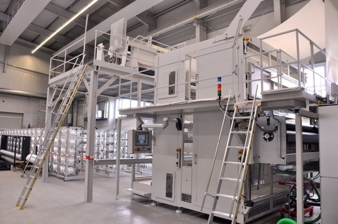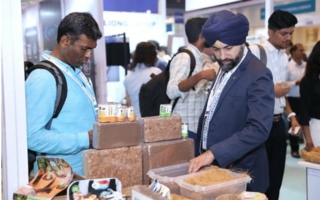27/04/2017 – Messe Frankfurt — auf Deutsch lesen
Techtextil 2017 – Ontec: The clever solution for efficient production of textile scrims
The great advantage of scrims lies in the fact that in general scrims are thinner by 20 to 40 percent in relation to fabrics with identical structure and comparable strength properties.
At the same time, the grid structure of scrims is less recognizable in the end product in comparison with fabrics. This results in a more even and smoother surface of the end product. In principle, a scrim has the form of a grid. It is produced out of endless fibres, same as woven or knitted fabrics. The threads are chemically reinforced and bonded together at the crossing points, so that the threads remain in the desired rectangular position. Contrary to fabrics, the binding of scrims is only effected on chemical basis. Scrims are mainly in use for reinforcement of most varied materials.
The ontec Turbotex is predominantly equipped with a creel, but in case of polyester fibre application, the use of a warp beam is recommended. Depending on the desired material construction, up to 1200 single bobbins can be applied. Two supply units take off the upper and the lower warp threads and supply the threads to the machine. The weft threads are supplied by max. 8 bobbins via a rotor, at a capacity of up to 4,000 wefts/min. This enables production speeds of up to 16 m/min. Compared to the weaving or knitting technology, a much higher productivity is achieved, and working widths up to 3,600 mm are possible. A patented transport and gripping device transports the produced scrim to the foulard for fixation with chemical products. Depending on the type of fibre, Latex, Acrylate or PVC dispersions/PVC plastisol are used as chemical bonding materials.
In a first step, the scrim is pre-fixed through contact drying and then finally dried in the infrared heating system. Furthermore, various materials like fleece, films or similar products can be fed to the scrim and simultaneously laminated and dried with the scrim. One respectively two panels can be processed at the same time. This processing method allows production of a finished product in just one working step.
Sensitive materials like paper, aluminium foils or other plastic films are effectively protected against ripping or dynamic tearing through lamination or integration of scrims. After the drying process, the material edges are trimmed and various centre cuts are possible. The material is wound on a batching device with additional centre drive. Options like an ejector for the fabric roll or an automatic transverse cutter are available.?
Ontec at Techtextil Hall 3.1 Booth J24




